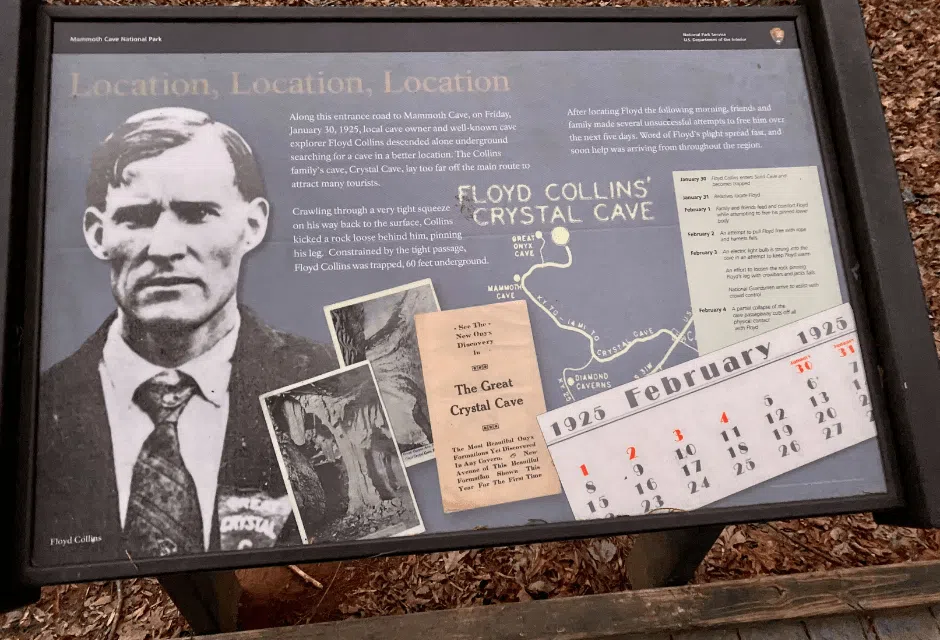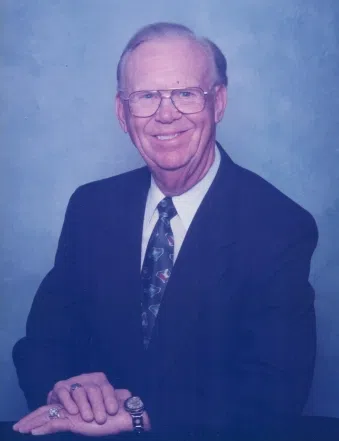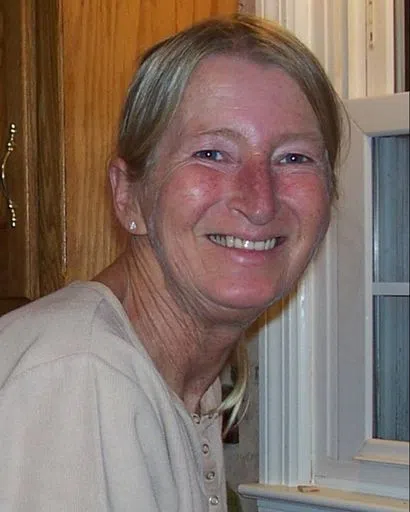This informational marker is posted about halfway down a trail leading to the entrance of Sand Cave where cave explorer Floyd Collins became trapped in early 1925. The trail is about a tenth of a mile from its head.
(BRENNAN CRAIN/WCLU NEWS)
By BRENNAN D. CRAIN, WCLU News
CAVE CITY — A Flint Ridge man went into a unexplored portion of cave in north Barren County nearly 98 years ago and never returned alive. That man was William Floyd Collins, and a descendant of his continues to tell about his daring task of exploring caves in the area around modern-day Mammoth Cave National Park.
Collins’ fascination with caves began before he was 10, said his great-great niece, Leticia Passmore Cline. He went on to operate a modest business in cave exploration and tourism.
“I grew up to this story almost daily,” Cline, who is the granddaughter to Collins’ niece, said. “We made our living at rock and gift shops. We kind of continue that tradition of making money off of tourism-based business or rocks and things under ground. It was just a part of our DNA.”
Many aspects of visits to the area “cave country” have changed since Collins was alive. For starters, visitors to Mammoth Cave were mostly wealthy people who could afford to travel to the area and journey beneath ground for long periods of time. That left locals hungry to cash in on the budding tourism opportunity.
Collins discovered a cave on his family’s farm just three miles past Mammoth Cave’s entrance. He called it Great Crystal Cave, which included larger rooms and spaces that were far more appealing than Mammoth Cave.
But there was one problem. There were too few visitors.
“He couldn’t get people to take that three extra miles to get to it, so he wanted to find one that was before Mammoth Cave,” Cline said. “At this time, he believed that all the cave systems were connected, and eventually they were. It’s been about 50 years since they connected the Flint Ridge cave system – which is where his caves were – to Mammoth Cave.”
Nearby in the ridge was another cave. It was located on a neighboring farm in a large depression of land. Collins agreed to share profits with the landowners if he was able to open another spot for tourists to visit.
Collins entered the cave on Friday, Jan. 30, 1925, and began his trek through the narrowing cave system. As he continued to squeeze through the narrow passageways, he eventually became stuck in place. A 13 pound rock had fallen on his ankle.
Edmund Turner, Collins’ business partner, noticed he had not returned from the excursion. He and a group of Collins’ relatives banded together to search for Floyd. Hours later they found his jacket outside the entrance of Sand Cave and realized he was trapped.
“He was trapped in a natural straight jacket,” she said. “His arms were pinned to his side. It was only a 13-pound rock that pinned his leg, but he just couldn’t bend down to move it. No one could really get down to him. They could get close enough, but you had to be pretty small.”
A crew of locals were banding together to find a way to extricate Floyd. By Monday, Feb. 2, 1925, the news of his entrapment had begun to spread across the region and state. A journalist named William “Skeets” Miller from the Courier Journal made his way to the site and later crawled through the cave to speak with Collins.
“Skeets” was a small man and a “gopher” reporter for the paper at the time. He later went on to win a Pulitzer Prize for his reporting at Sand Cave because he told the most accurate accounts amid falsities devised to sell more papers, Cline said.
The main road – now called Old Mammoth Cave Road – was merely a pathway of dirt in 1925. Eventually, hundreds of spectators traveled that road and amassed in the wooded area surrounding Sand Cave’s entrance – so many that the National Guard was posted at the site to control the crowd and enforce Prohibition era laws.
“I always say were like the Kennedys of the caves because we’ve got the fame and the tragedy,” Cline said.
Elements of the Collins and Passmore family tragedy trickled into the decades beyond Floyd’s death. His sister Nellie Collins Leach was placed in a mental institution sometime after his death; a brother of his died in a factory accident; another sister, Anna Bowles Collins Carney, died after she was shot to death in 1934 after refusing her husband a divorce.
Collins was dead by the time rescuers found a way to him. That was Monday, Feb. 16, 1925.
Floyd’s family decided to leave his body in the cave and closed it with debris. He was later exhumed and moved five times before he was placed to final rest in the cemetery next to Mammoth Cave Baptist Church in the 1980s.
“My whole family is buried there and the old homestead is three miles down the road.”
The trailhead to Sand Cave is located at the entrance to Mammoth Cave National Park along Highway 255. The cemetery where Floyd is buried is located along Flint Ridge Road.
Cline said Mammoth Cave’s recognition was born out of tragedy, whether it was from inhumane exploration practices involving slaves, the provocation of Native American artifacts or Floyd Collins’ death. But she remains confident Collins’ death expedited Mammoth Cave’s reputation as one of the world’s greatest attractions.
“I feel like without Floyd it would have been a lot longer of a process to get recognition and notice into that cave,” she said.
Find more information about Floyd Collins and his death at NPS.gov.












